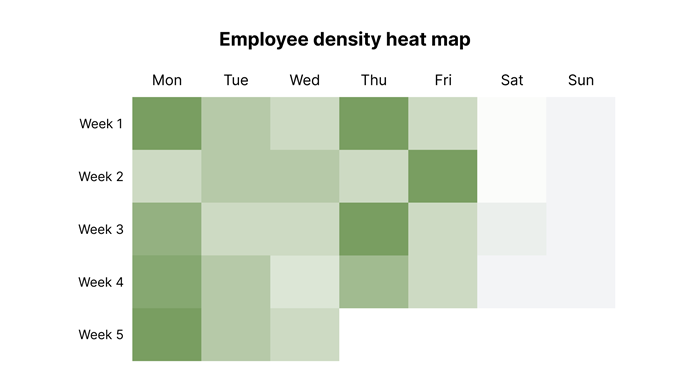With inflation at an all-time high, most organizations are looking at this year’s budgets with nervous anticipation.
So, while the past year has very much been centered around either getting employees to return to the office, or getting the workplace set up to function properly in a hybrid manner, this year will likely hold a larger focus on streamlining your budgets and reducing expenses.
And as facility managers we have a big opportunity to impact these goals, specifically through the way we go about managing the office. So, let’s look at three different ways facility management can help reduce the organizational spend.
1. Reduce your office size or rent out idle space
Real estate usually makes up the larger part of any facilities budget. Simply put, the buildings are usually worth more than what you put in them. But that doesn’t mean we can’t look at how big the real estate post is.
One of the reasons hybrid work has been as successful as it has, is because it allows companies to make better use of their premises. This has been especially helpful for smaller organizations looking to expand, as the need to rent additional space can be pushed as far as their hybrid policy allows.
But for bigger companies looking into how space is utilized can be quite beneficial too.

After you find out how your office is used you can start rethinking the size of your office, and even if you can’t reduce the size of your office due to lease restrictions, there’s the option of renting out workstations to freelancers or other companies, or changing the purpose of certain areas so they provide more value than empty desks.
The only thing you need in order to make this happen, is a structured overview of how your office is being used.
2. Getting more out of your resources
While not an actual cost reduction, improving how your current facilities are used will function as a long-term cost reduction, simply because it will slow down the speed with which you will need to expand certain functions or reduce what you spend on resources that actually go unused.
Meeting rooms, for instance, make up a sizeable portion of any real estate expense, and with the average European 20 square meter meeting room being priced at 10400 euros annually[1] it’s not a small investment to add yet another meeting room to your premises. Especially when considering that most organizations only have a utilization rate around 25 percent.[2]
In essence this means that 75 percent of the cost of your meeting rooms, or 7800 euros per 20 square meters of meeting room, is being wasted simply by not being used. And from that perspective, increasing the utilization rate of your meeting rooms might be just as beneficial in these times as any other type of cost reduction.
3. Reduce what you spend on soft resources
Optimizing your office to reduce spend on things like electricity, heat, water etc. is often solved with things like sensors to automatically adjust heat or turn off the lights. But those are the "hard" resources involved in facility management. As facility management we also have the possibility of helping reduce the spend on "softer" resources.
Not every organization provides employees with free lunches, and the cost of these often falls outside the scope of the facilities budget, but even so facilities services does have an opportunity to heavily impact the budget of the organization on this one.
You see, employee lunches can be a costly affair. This was made evident in the late months of 2022 as several newspapers reported on Elon Musk’s plans to scrap employee lunches at Twitter's San Francisco headquarters, as they ran a bill of $13 million a year.[3]
Now, completely scrapping employee lunches or similar luxuries is one way to make room in the budget, but it is also a tad drastic. Another route is to successfully scale such services to the actual number of users instead of simply cooking up meals for 90% of your staff every day, and throwing away the leftovers.
Provided with a way to track and forecast how many employees are actually using the office, catering will be able to scale the amount of food with the number of employees. At our own offices, we’ve managed to reduce lunch expenses by 29 percent.
What's next?
There are many different ways to reduce your office expenses, but the point here isn't to list every single one. The point is to make a broader illustration of the different ways in which you as facility management can reduce the costs of running an office, albeit by supplying three quite specific examples.
First, there’s the confines of the office in general. Reducing the spend on real estate and utilities can have a real impact, the how of it is usually the more troublesome issue. However, with hybrid work there’s plenty of room to be imaginative on this count.
Second, there’s resource optimization. While correcting poor use of resources may not always show itself in the figures of a budget, it still holds quite the potential. In the example here we talked about meeting rooms, but we might as well have talked about turning off the light to reduce the energy bill.
And lastly there are the soft resources such as catering for employees. In most cases this will not be part of the facilities budgets in any way, shape or form, but it does, however, illustrate how improvements made by facility management can have far-reaching effects.
In the end, which ever route you choose you will most likely need a way to either monitor where employees work from, so you can scale either facilities sizes or softer resources to match the number of daily users, or you need a way to increase the utilization rate of resource like meeting rooms.
References
[1] https://www.statista.com/statistics/858101/average-annual-office-rent-cost-per-square-meter-by-european-country/
[2] https://signinworkspace.com/resources/blog/are-unoccupied-meeting-rooms-draining-your-facilities-budget
[3] https://nypost.com/2022/11/14/musk-plans-to-end-free-lunch-at-twitter-hq-claims-meals-cost-13m-a-year/

